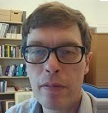1.9: The sub-structure of the nucleon (Quantum Chromodynamics)
- Page ID
- 15213
In 1964 Gell-Mann and Zweig introduce the idea of quarks: particles with spin 1/2 and fractional charges. They are called up, down and strange and have charges \(2/3,-1/3,-1/3\) times the electron charge.
Since it was found (in 1962) that electrons and muons are each accompanied by their own neutrino, it is proposed to organise the quarks in multiplets as well: \[\begin{array}{lll} e & \nu_{e} & (u,d)\\ \mu & \nu_{\mu} & (s,c) \end{array}\] This requires a fourth quark, which is called charm.
In 1965 Greenberg, Han and Nambu explain why we can’t see quarks: quarks carry color charge, and all observe particles must have color charge 0. Mesons have a quark and an antiquark, and baryons must be build from three quarks through its peculiar symmetry.
The first evidence of quarks is found (1969) in an experiment at SLAC, where small pips inside the proton are seen. This gives additional impetus to develop a theory that incorporates some of the ideas already found: this is called QCD. It is shown that even though quarks and gluons (the building blocks of the theory) exist, they cannot be created as free particles. At very high energies (very short distances) it is found that they behave more and more like real free particles. This explains the SLAC experiment, and is called asymptotic freedom.
The \(J/\psi\) meson is discovered in 1974, and proves to be the \(c\bar c\) bound state. Other mesons are discovered (D0, \(\bar u c\)) and agree with QCD.
In 1976 a third lepton, a heavy electron, is discovered (\(\tau\)). This was unexpected! A matching quark (b for bottom or beauty) is found in 1977. Where is its partner, the top? It will only be found in 1995, and has a mass of 175 GeV/c\(^2\) (similar to a lead nucleus…)! Together with the conclusion that there are no further light neutrinos (and one might hope no quarks and charged leptons) this closes a chapter in particle physics.


